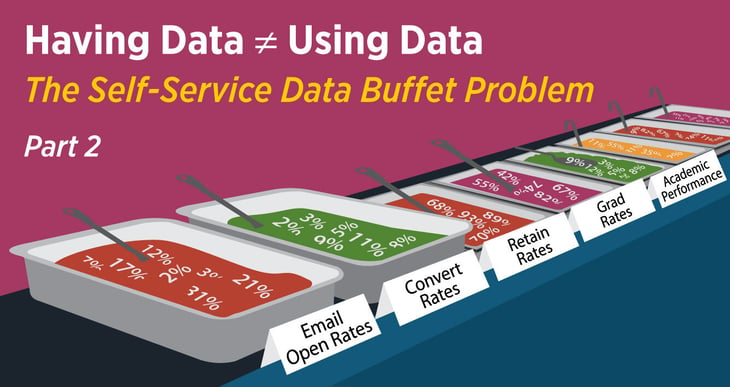
Last week’s blog post helped define the data use problem (find Part 1 here). This week, taking us further into what to do about it.
Trust us, you’re not the only team whose data is not living up to its potential. It’s fairly common within teams and business units. It’s an issue of lack of time and/or lack of skills, but a problem worth solving.
Because, without well-played data, your team is making decisions based on gut reactions and are more likely to participate in group think. That route is often poorly informed and heavily biased. Data informs and confirms.
Data also drives curiosity. When your brain (or your team) has one of those aha! moments based on data, it craves more. New market opportunities start to unveil themselves. New approaches to doing the work (operations) emerge. Prospective student enrollment pain-points will become more apparent – and the ramifications of leaving those pain points unresolved.
Sure, data won’t solve these problems – that’s up to you – but it will help ensure the problems you’re solving are the ones worth pursuing. Data should be the foundation to most of the decisions you make.
Now, we don’t want to overstate it. Data is not magic (though what our data gurus pull out of the hat can feel like it!). It’s simply math. It’s what you do with that math – that’s the magic. And that’s why every team needs access to digestible data and why self-service data analytics should be a priority for you. It certainly is for us.
This week we offer a process for helping you do just that. It’s a practical 5-step approach that starts with goal-setting and collaboration. Read on.
Considering the data use solution: 5 steps
At the institution level, this can be a massive undertaking. At the business unit level, it can be more manageable and shorter-term.
Here’s a pared-down high-level approach for your consideration. Need help with any of this? Be in touch.
Step 1: Define your goal.
Your to-do: Determine what it is you want to achieve. Know the questions you want answered. Know which problems you are really trying to solve.
Step 2: Collaborate.
Your to-do: Bring in all stakeholders to not only discuss your goals, but to identify and share data sources. Know which departments have what kind of data so it can be centralized and put to use in this effort.
Step 3: Get a data analyst on board and make them available to the team (not overworked).
Your to-do: Bring in an expert who understands how to look at all the data sources available that will inform actionable recommendations for your institution or business unit. This is what data dashboard projects are all about and it takes time. The first drafts require use and revision over time before you will discover what you really need. Important caveat: a major assumption here is that your data is clean and accurate (enough). That is a really big assumption and cleaning your data is an entirely different challenge to address. A useful perspective is in our Edu CRM Planning Guide available to our Intead Plus members.
Step 4: Pull the available data into a dashboard tool.
Your to-do: Bring in the data API talent to get data from multiple sources into a single data silo that can produce data visualizations that less data inclined humans can understand. This may be the same data analyst from step 3. Often step 3 requires a data strategist and this step 4 requires someone with more technical coding skills.
Step 5: Train your team.
Your to do: Self-service data tools are way easier (and way more reliable) to use than manual data manipulation. But not everyone on your team will feel immediately comfortable with the tool. Invest in training so each member of your team knows what the tool can do and how to do it. Repeating our observation from last week: Creating, viewing, and understanding reports is not as simple as the tech vendors tell you it is.
Self-service data is no longer a nice-to-have, it’s critical to smart decision making. That fact doesn’t make it feel any less cumbersome, though.
Let us help. We can help you think through your data goals, business unit needs, the valuable data sources, and your best steps forward. It’s the kind of strategic work we’re doing every day. And we’d love to do it with you. Be in touch.



